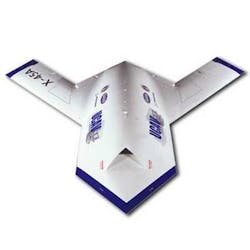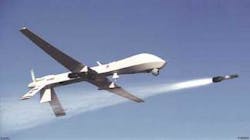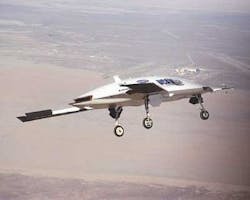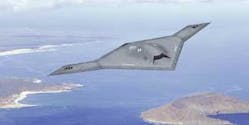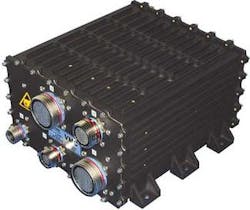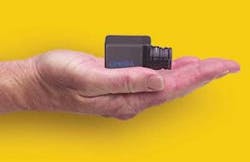By John McHale
Unmanned aerial vehicles have traditionally been used for surveillance of potential battlefields and enemy locations. However, with the arming of the Predator during the conflict in Afghanistan and work on the U.S. Department of Defense's Joint Unmanned Combat Aerial System, pilotless aircraft in the U.S. arsenal are becoming deadly.
The recent wars in Afghanistan and Iraq showed the advantages that unmanned aerial vehicles (UAVs) bring to the battlefield. Not only do they provide surveillance with stealth but they do so without putting pilots at risk.
The two most famous UAVs — the high-altitude Global Hawk from Northrop Grumman and the Predator from General Atomics Aeronautical Systems — gained recognition in the mid-1990s for performing intelligence, surveillance, and reconnaissance roles. Both planes are produced at their respective company's San Diego facilities.
null
Predators, equipped with electro-optical sensors and infrared video cameras, flew 50 targeting sorties in Kosovo, defense officials say. The UAVs also carried laser designators to illuminate targets for combat aircraft. Predator also has been an asset to militaries worldwide by providing real-time day and night video of areas of interest to commanders.
U.S. military leaders want UAVs to take on more of a combat/attack role, despite their utility as surveillance platforms. For this reason, the Defense Advanced Research Projects Agency's (DARPA) Joint Unmanned Combat Air System (J-UCAS) was created to field a plane by 2008. In the meantime, Air Force leaders decided to arm the Predator UAV.
Predator
Target acquisition for piloted aircraft was one function of the U.S. Air Force Predator during recent military operations. Once the UAV's sensors acquired a target, operators on the ground alerted joint commanders to send in a piloted aircraft for a strike. Frustratingly, however, sometimes the manned aircraft arrived too late.
To correct this problem, military officials decided to arm Predators with Hellfire-C laser-guided missiles fired from U.S. Army helicopters, says John Porter, manager of business development for General Atomics Aeronautical Systems. Much of the credit for arming Predator goes to Air Force Chief of Staff Gen. John Jumper.
Air Force and General Atomics officials were working on arming the Predator before Sept. 11, 2001. The first launch of a live missile was early that year. The Predator program evolved from a non-lethal, reconnaissance asset, to an armed, highly accurate tank-killer, say senior program officials from Air Force Air Combat Command (ACC) at Langley Air Force Base, Va.
Integrating the Hellfire missiles and electronics was easy, Porter says. Essentially, General Atomics took the box that enables the pilot to launch the missiles and integrated it into the aircraft. The laser targeting system was already in place to hold spot targets for piloted aircraft. The Predators are also capable of firing Stinger heat-seeking air-to-air missiles.
The Predator uses satellite and line-of-sight communication links to launch the missile, which itself was re-engineered to operate at high altitudes, Northrop Grumman officials say. Hellfire missiles are normally launched from helicopters flying lower than 2,000 feet, or from the deck of a Navy aircraft carrier.
Engineers will configure the next-generation Predator B as a 10,000-pound gross-takeoff-weight aircraft that can operate at altitudes higher than 50,000 feet for more than 30 hours and carry more than 800 pounds of internal payload and 3,000 pounds of external payload. Predator B flies faster than 200 knots.
The new aircraft also is to support several military objectives and a variety of scientific research applications, company officials say. ALTAIR, a variant of the militarized Predator B, flew earlier this year and will support NASA's atmospheric research. In addition to its scientific research missions, the aircraft will see extensive U.S. Navy and Coast Guard use for maritime surveillance and homeland defense missions because of its 44-hour endurance and large payload.
ALTAIR is to be the first remotely piloted aircraft to meet requirements for flights in U.S. civil airspace; it has a dual fault-tolerant architecture flight-control system and triple-redundant avionics to increase reliability. The aircraft will be integrated with an automated collision-avoidance system as well as an air-traffic-control voice relay for national airspace missions.
Last year the Predator became the first UAV to launch a mini-UAV while in flight. Known as a Flight Inserted Detector Expendable for Reconnaissance (FINDER), this 57-pound mini-UAV attached to a pylon under Predator's wing and released at an altitude of 10,000 feet. FINDER conducted a 25-minute preprogrammed mission before landing on a dry lakebed at Edwards Air Force Base, Calif. Predator can carry two FINDERs, Northrop Grumman officials say.
The Naval Research Laboratory (NRL) FINDER mini-UAV program is part of the Defense Threat Reduction Agency (DTRA) airborne sensor program, which is designed to evaluate Predator's capability to carry and launch independently controlled and self-propelled mini-UAVs into hazardous conditions. Once launched, the small UAV can help military personnel conduct atmospheric sampling and assessments prior to any combat strikes. Leaders can get access to FINDER information in real time.
J-UCAS
The Joint Unmanned Combat Air System (J-UCAS) is to demonstrate how well a networked system of armed UAVS could suppress enemy air defenses, as well as conduct surveillance and precision strikes within the emerging global command and control architecture, DARPA officials say. J-UCAS is a joint DARPA/Air Force/Navy effort.
The J-UCAS program combines the DARPA/USAF Unmanned Combat Air Vehicle (UCAV) and the DARPA/Navy Naval Unmanned Combat Air Vehicle (UCAV-N) programs. These efforts were specifically targeted toward their service-specific needs, yet DOD officials saw more synergy by combining the programs, officials say.
DARPA's Joint Systems Management Office (JMSO) leads the DOD effort to develop and demonstrate a Joint Unmanned Combat Air System. The JSMO staff includes representatives from DARPA, the Air Force, and the Navy. The management office, which began operations Oct. 1, is collocated with DARPA's other offices in Arlington, Va.
New design philosophies on the J-UCAS could optimize the design for aerodynamics, signature, reduced maintenance, and low-cost manufacturing processes, DARPA officials say. Advances in small smart munitions will allow these smaller vehicles to attack several different targets during one mission. This would reduce the cost per target killed, while minimizing the prospects for geolocation errors and fratricide. Improvements in sensor technologies also enable significant advances in surveillance and reconnaissance over high threat areas.
null
The initial Air Force operational role for the J-UCAS is as a "first day of the war" force enabler that will complement a strike package by suppressing enemy air defenses, DARPA officials say. In this role, J-UCAS would destroy or electronically suppress sophisticated enemy integrated air defense systems (IADS) before manned bombers entered the area. The J-UCAS aircraft also would attack important time-critical targets. Post conflict, the J-UCAS could patrol and enforce no-fly zones.
The initial role for the Navy's J-UCAS is to provide carrier-based surveillance, reconnaissance, and targeting to complement manned aircraft and cruise missiles. Technological challenges in designing the J-UCAS include developing an affordable, lethal, low-observable air vehicle capable of dynamic distributed control using advanced cognitive aids and advanced targeting processes, officials say.
Experts at Boeing Phantom Works in Seattle and Northrop Grumman Air Combat Systems in El Segundo, Calif., are designing demonstrator vehicles for the J-UCAS demonstration program, DARPA officials say. The J-UCAS program is in several phases, the first of which consists of two X-45A and one X-47A demonstrator aircraft and their associated simulation, mission control, and support systems.
Experts from Northrop Grumman and Boeing will focus on a common set of service objectives, which include a combat radius of 1,300 nautical miles with a full payload of 4,500 pounds. In Phase IIB of the Naval UCAV effort, Northrop Grumman plans to develop at least two full-scale demonstrator vehicles. Boeing, meanwhile, will develop at least three X-45Cs for demonstrations.
Boeing
Each of Boeing's first two X-45A air vehicles has one working weapons bay, with an avionics pallet located in the other bay. The X-45A is all electric, except for the nose wheel steering and hiking system, and feeds its engine through a serpentine inlet. The two X-45As, each of which uses a yaw thrust vectoring system have demonstrated the command, control, communications, and navigation systems, as well as the aircraft's aerodynamic envelope, DARPA officials say.
Boeing engineers designed the UCAV with an open architecture and commercial off-the-shelf (COTS) electronics whenever possible, says Barbara Sando, J-UCAS director of mission systems at Boeing. In some instances such as the processor, the COTS device was modified for use in the UCAV, she adds.
Software is also a key feature of the X-45A Spiral 0 version, which has four software blocks, each one with increased capability, Sando says. Boeing officials declined to go into specific characteristics of the UCAV electronics.
The aircraft will have four levels of autonomy, says Randy Roethe, mission systems integration team manager for J-UCAS at Boeing. The first level has the ground controller make all decisions. The second level allows the aircraft to make assumptions of what to do in a particular situation, and then asks the operator to make a decision. The third level gives the operator a time limit in which to respond to the UCAV, or the UCAV will make the decision on its own. Level 4, which is fully autonomous, uses mission parameters without operator input. All of these depend on the mission requirements and rules of engagement, says Steve Teske, J-UCAS business development manager for Boeing.
null
Unlike the Predator vehicle, the UCAV ground controller, does not sit in a cockpit and control the plane with a stick, says Teske. Instead, the controller gives commands to the aircraft with a computer monitor and keyboard, but does not actually "fly" the plane. Eventually the operator will operate as many as four different aircraft at once in a wave on the same missions, he says.
"Air Force leadership has made it very clear that the UCAV system must interoperate within the manned environment," says Andy Gutierrez, the government X-45A chief systems engineer at Boeing. "Manned airspace control procedures are not going to substantially change and the design of the UCAV must adapt so that it can safely and effectively operate in such an environment."
UCAVs could significantly increase the effectiveness and survivability of manned fighter aircraft while lowering the overall cost of combat operations; because of their small size, lack of pilot interfaces and training requirements, reusability, and long-term storage capability, UCAVs are projected to cost as much as 65 percent less to produce than future manned fighter aircraft, and as much as 75 percent less to operate and maintain than current systems, Boeing officials say.
To suppress air defenses, the UCAV may have precision-guided weapons such as the Joint Direct Attack Munition (JDAM) and the Small Diameter Bomb (SDB). A typical scenario would call for several different UCAVs with preprogrammed objectives and preliminary targeting information from ground-based mission planners. The UCAVs may carry out their mission autonomously, work interactively with ground controllers, or take targeting orders from controllers.
Upon return to base, ground crews can prepare the UCAV immediately for another mission, or remove the wings and place the aircraft into a container for shipment elsewhere or for storage for as long as 10 years. Container interfaces allow for periodic maintenance monitoring and software updating of the vehicle's systems. The UCAV can be reassembled and prepared for combat in 60 to 90 minutes.
Northrop Grumman
Northrop Grumman built the X-47A, which demonstrated low-speed handling qualities, air-vehicle performance, and navigation-performance collection. It also simulated a tailhook-arrested landing on a carrier flight deck by landing near a predesignated touchdown point using the shipboard-relative global positioning satellite (SRGPS) system as the primary navigation source for landing precision, DARPA officials say.
Company engineers are working on the X-47Bs to demonstrate Navy missions from an aircraft carrier. Engineers will also demonstrate how a UCAV can be used to satisfy U.S. Air Force mission requirements, using technology they applied to the Global Hawk and Fire Scout UAVs, says Scott Sullivan, deputy director of J-UCAS at Northrop Grumman.
null
The X-47B will use the same tactical common data link as the Global Hawk and use other software solutions leveraged off the company's UAV programs as well as work done on the Joint Strike Fighter (JSF) program, Sullivan says. The J-UCAS will combine Global Positioning Systems and other sensor technology.
One of the program's unique features is the ability of its software to monitor itself, Sullivan says. If one part malfunctions, the system automatically switches to a backup, essentially taking the role of the pilot. The X-47B's COTS technology included an ARC210 radio and a 1553 databus. Designers are considering Fibre Channel for use in the aircraft, he adds.
The goal of the Phase IIB of the Naval UCAV program is to demonstrate a UCAV able to operate on an aircraft carrier deck, use carrier-based command-and-control systems, launch from a carrier catapult and make an arrested carrier landing. Northrop Grumman's concept combines the "kite" aerodynamic shape of the company's tail-less X-47A Pegasus experimental unmanned vehicle with a "flying wing" shape. The kite design enables efficient integration of propulsion and weapons, while the wing extensions provide aerodynamic efficiency, company officials claim.
Northrop Grumman to produce class IV unmanned aerial system for U.S. Army Future Combat System
The Northrop Grumman Corp. Integrated Systems sector in El Segundo, Calif., was recently named an industry partner on the U.S. Army's Future Combat System (FCS) program by Boeing in Seattle and Science Applications International Corp. (SAIC) in San Diego, the program's lead system integrators.
Integrated Systems will develop and produce the FCS program's Class IV unmanned aerial system (UAS) based on the RQ-8 Fire Scout vertical takeoff and landing tactical unmanned aerial vehicle (VTUAV).
The Class IV UAS will be a key element of the tactical intelligence, surveillance, reconnaissance and targeting architecture, providing real-time imagery and data collection and dissemination at the brigade level, Northrop Grumman officials say.
Integrated Systems experts will base the company's Class IV unmanned aircraft on the RQ-8 Fire Scout VTUAV system currently in test and evaluation for the U.S. Navy. The system has been in development and low-rate initial production since 2000. Fire Scout has flown more than 75 test flights since May 2002 demonstrating its ability to take off, fly, navigate, land autonomously, and collect imagery from its onboard sensor payload, Northrop Grumman officials say. Company officials have planned additional flight tests later this year to demonstrate other sensors and forward firing weapons targeting.
The Boeing-SAIC team chose the Northrop Grumman Baltimore-based Electronic Systems sector to serve as the aerial sensor integrator for FCS. Electronic Systems will integrate the surveillance, reconnaissance, and target-acquisition systems on the FCS unmanned aerial platform.
For more information contact NorthropGrumman Integrated Systems online at www.is.northropgrumman.com.
3U SBS computer flies on Global Hawk
The VMC chassis with a version of the AMC-cPCI-3000 computer from SBS Technologies in Albuquerque, N.M., is serving as the flight computer on the Global Hawk Unmanned Aerial Vehicle (UAV) from Northrop Grumman in San Diego.
Northrop Grumman designers bought the SBS device off the shelf with the only modification in the I/O, says Frank Willis, vice president of government business development at SBS. SBS engineers added a digital signal-processing core on a field programmable gate array from Altera in San Jose, Calif., to have reconfigurable I/O for the UAV's mission requirements, he explains.
SBS's AMC-cPCI-3000 family is an advanced 3U CompactPCI ruggedized computer for flight management/mission computing, display processing, and information management. This flight-qualified COTS computer system is suited for a variety of avionics, vetronics, navigation, and space programs for which time to market is critical, company officials say.
null
This system was built on open systems architecture to allow for technology insertion. It leverages SBS' COTS products, conforms to open standards, and uses real-time operating system software.
The AMC-cPCI-3000 comes with an off-the-shelf power supply, a ruggedized 3U cPCI PowerPC-based RL4 or CM4 single-board computer running as fast as 500 MHz, and includes Fast Ethernet, four serial ports, parallel I/O, built in test (BIT), and VxWorks or Green Hills Integrity real-time operating systems.
The standard configuration also includes a dual-channel 1553 PMC, high-speed serial card, Digital I/O module with eight channels of opto-coupled discrete inputs, eight channels of opto-coupled discrete outputs, and 16 channels of general-purpose bidirectional discretes that can be programmed individually as outputs or inputs.
For added reliability, SBS uses a CompactPCI transition module instead of a traditional wiring harness between the front panel and the backplane. External fins provide additional heat-sinking capability, allowing the system to take advantage of surrounding airflow, company officials say.
For more information on the AMC-cPCI-3000 contact SBS online at www.sbs.com.
Indigo Systems tiny IR cameras fly on UAVs
A tiny Omega infrared camera from Indigo Systems in Goleta, Calif., is the infrared payload for the Small UAV (unmanned aerial vehicle) system deployed in numerous reconnaissance missions during recent conflicts by the U.S. Marine Corps.
More than 150 Omega miniature, uncooled microbolometer cameras from Indigo have been configured as payloads on these Small UAVs to capture real-time thermal images for tactical surveillance from altitudes of several hundred feet, Indigo officials say.
The Omega infrared microsensor is compact, weighs less than four ounces, including lens, and performs over an operating temperature range of –40 degrees to 55 degrees Celsius.
null
The uncooled microbolometer provides a spectral response from 7.5 to 13.5 microns. With time to image less than one second from turn-on, the standard input voltage range is 3.5 to 9.0 volts DC and power consumption is less than 1.5 watts, company officials say.
Other military applications for Omega include helmet-mounted imagers, rifle sights, unmanned ground vehicles (UGVs), and unattended ground sensors.
Current production rate is 400 to 500 units per month with a 30-day lead-time. Preferential delivery is available for government contracts with a DO- or DX- priority rating.
For more information on Indigo Systems contact the company online at www.indigosystems.com.
